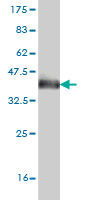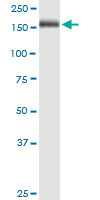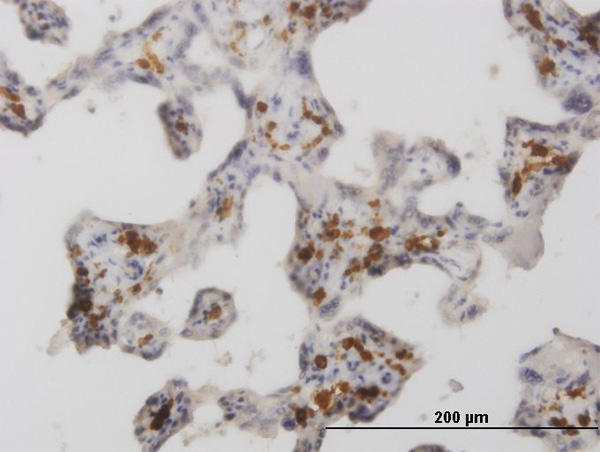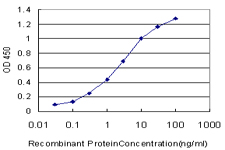MRC1 Antibody (monoclonal) (M02)
Mouse monoclonal antibody raised against a partial recombinant MRC1.
- 产品详情
- 文献引用 : 1
- 实验流程
- 背景知识
Application
| WB, IHC, E |
|---|---|
| Primary Accession | P22897 |
| Other Accession | NM_002438 |
| Reactivity | Human |
| Host | mouse |
| Clonality | monoclonal |
| Isotype | IgG1 Kappa |
| Clone Names | 5C11 |
| Calculated MW | 166012 Da |
| Gene ID | 4360 |
|---|---|
| Other Names | Macrophage mannose receptor 1, MMR, C-type lectin domain family 13 member D, C-type lectin domain family 13 member D-like, Macrophage mannose receptor 1-like protein 1, CD206, MRC1, CLEC13D, CLEC13DL, MRC1L1 |
| Target/Specificity | MRC1 (NP_002429, 22 a.a. ~ 130 a.a) partial recombinant protein with GST tag. MW of the GST tag alone is 26 KDa. |
| Dilution | WB~~1:500~1000 IHC~~1:100~500 E~~N/A |
| Format | Clear, colorless solution in phosphate buffered saline, pH 7.2 . |
| Storage | Store at -20°C or lower. Aliquot to avoid repeated freezing and thawing. |
| Precautions | MRC1 Antibody (monoclonal) (M02) is for research use only and not for use in diagnostic or therapeutic procedures. |
For Research Use Only. Not For Use In Diagnostic Procedures.

Provided below are standard protocols that you may find useful for product applications.
BACKGROUND
The recognition of complex carbohydrate structures on glycoproteins is an important part of several biological processes, including cell-cell recognition, serum glycoprotein turnover, and neutralization of pathogens. The protein encoded by this gene is a type I membrane receptor that mediates the endocytosis of glycoproteins by macrophages. The protein has been shown to bind high-mannose structures on the surface of potentially pathogenic viruses, bacteria, and fungi so that they can be neutralized by phagocytic engulfment. This gene is in close proximity to MRC1L1. The gene loci including this gene, MRC1L1, as well as LOC340843 and LOC340893, consist of two nearly identical, tandemly linked genomic regions, which are thought to be a part of a duplicated region.
REFERENCES
1.Increased malignancy of oral squamous cell carcinomas (oscc) is associated with macrophage polarization in regional lymph nodes - an immunohistochemical study.Wehrhan F, Buttner-Herold M, Hyckel P, Moebius P, Preidl R, Distel L, Ries J, Amann K, Schmitt C, Neukam FW, Weber MBMC Cancer. 2014 Jul 21;14:522. doi: 10.1186/1471-2407-14-522.2.Alternative activation of laser-captured murine hemophagocytes.Canna SW, Costa-Reis P, Bernal WE, Chu N, Sullivan KE, Paessler ME, Behrens EMArthritis Rheumatol. 2014 Jan 27. doi: 10.1002/art.38379.3.Small oral squamous cell carcinomas with nodal lymphogenic metastasis show increased infiltration of M2 polarized macrophages - an immunohistochemical analysis.Weber M, Buttner-Herold M, Hyckel P, Moebius P, Distel L, Ries J, Amann K, Neukam FW, Wehrhan F.Journal of Cranio-Maxillofacial Surgery(2014), doi: 10.1016/j.jcms.2014.01.035.4.Xanthogranulomatous cholecystitis: A clinicopathological study of its association with gallbladder carcinoma.Zhuang PY, Zhu MJ, Wang JD, Zhou XP, Quan ZW, Shen J.J Dig Dis. 2012 Sep 21. doi: 10.1111/j.1751-2980.2012.00645.x. [Epub ahead of print5.Coronary Atherosclerosis Is Associated With Macrophage Polarization in Epicardial Adipose Tissue.Hirata Y, Tabata M, Kurobe H, Motoki T, Akaike M, Nishio C, Higashida M, Mikasa H, Nakaya Y, Takanashi S, Igarashi T, Kitagawa T, Sata M.J Am Coll Cardiol. 2011 Jul 12;58(3):248-55.
终于等到您。ABCEPTA(百远生物)抗体产品。
点击下方“我要评价 ”按钮提交您的反馈信息,您的反馈和评价是我们最宝贵的财富之一,
我们将在1-3个工作日内处理您的反馈信息。
如有疑问,联系:0512-88856768 tech-china@abcepta.com.






















 癌症的基本特征包括细胞增殖、血管生成、迁移、凋亡逃避机制和细胞永生等。找到癌症发生过程中这些通路的关键标记物和对应的抗体用于检测至关重要。
癌症的基本特征包括细胞增殖、血管生成、迁移、凋亡逃避机制和细胞永生等。找到癌症发生过程中这些通路的关键标记物和对应的抗体用于检测至关重要。 为您推荐一个泛素化位点预测神器——泛素化分析工具,可以为您的蛋白的泛素化位点作出预测和评分。
为您推荐一个泛素化位点预测神器——泛素化分析工具,可以为您的蛋白的泛素化位点作出预测和评分。 细胞自噬受体图形绘图工具为你的蛋白的细胞受体结合位点作出预测和评分,识别结合到自噬通路中的蛋白是非常重要的,便于让我们理解自噬在正常生理、病理过程中的作用,如发育、细胞分化、神经退化性疾病、压力条件下、感染和癌症。
细胞自噬受体图形绘图工具为你的蛋白的细胞受体结合位点作出预测和评分,识别结合到自噬通路中的蛋白是非常重要的,便于让我们理解自噬在正常生理、病理过程中的作用,如发育、细胞分化、神经退化性疾病、压力条件下、感染和癌症。









